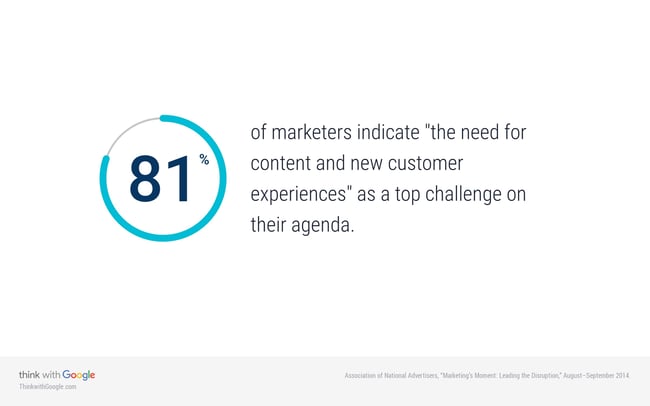How to make valuable content is a question that should be at the forefront of every writer’s mind. In modern times there are several methods for consuming written content, which raises the question;
How do you read?
You might be a print-book purist, like 38 percent of Americans; you might belong to the 28 percent of people who throw an e-reader or mobile reader app into the mix. Perhaps you identify with the quarter of Americans that didn’t read a book in the last year, but you keep up with news. (If that’s the case, do you usually watch, read or listen to your favorite journalists – and did you know that I can probably guess your answer based on your age?)
Today, writers have a level of autonomy over their work that was unprecedented a decade ago. In the literary sphere, the rise of e-books and self-publishing made it possible for anyone to create, market and distribute a book using their own resources, rather than going through a literary agent and major publishing house. B2B brands have recognized that organizations with blogs receive 67 percent more leads, while blogging is this year’s No. 1 inbound marketing priority in North America. In other words, it’s easier than ever to publish, distribute and reap ROI from your own words – and this opportunity is as inspiring as it is chaotic.
When every voice has the potential to resonate on a global scale, it’s not hard to see why individual perspectives can get drowned out. This applies equally to book authors selling their latest work in the Kindle store and executives sharing their long(ish)form thoughts on channels like Medium, LinkedIn and company blogs. Both groups also share a key ingredient for rising above the competition: they need credibility to convince audiences to listen.
The Key to Credibility: Third-Party Data
If I didn’t back up my claims with sources, would you have believed how much B2B blogging pays off or the number of people who didn’t read a book last year? Maybe, maybe not. For executives looking to become thought leaders in their industries, however, it’s not worth taking a chance.
Your writing should always demonstrate your mastery of and insights about your area of expertise. BuzzSumo recently highlighted a few content ingredients that tend to attract high numbers of shares and domain links, finding that authoritative voices, strong opinions and trending topics are reliable factors. One common ingredient in every type of content, however, was the use of original or third-party data to back up writers’ insights and tips. By establishing a connection between your claims and relevant data, you can easily produce writing that’s worthy of your readers’ interest, shares, links and subscriptions.
The 5 Tried and True Tips to Make Valuable Content
Below are five ways to pepper your brand’s editorial calendar with data and watch as your content becomes more educational, authoritative and valuable in the long run.
1. Collect, Distill and Deliver Information Your Customers Need to Know
From speaking with experts directly to keeping up with the latest reports about your industry, collecting and analyzing data that helps move the needle for your customers involves a fair amount of legwork. After Metis client Teikametrics co-hosted a webinar with BigCommerce, the team published a blog about winning the future of retail by the numbers – bringing the important figures front and center to help give readers an edge.
2. Dispel a Common Myth
Do you ever hear misconceptions thrown around your industry to the point where customers believe them, and that belief puts the well being of their businesses at risk? Neil Glazebrook, vice president of product management at ClearSky Data, noticed that many of his customers were tracking their data storage costs with a narrow measurement approach. By measuring the dollars they spent per gigabyte of storage, those users weren’t taking other cost factors into account – and overlooking some of the ways the data storage industry had evolved in recent years. His blog post, “Three myths about data storage TCO that need to go,” shared insight to help companies update their views and open their minds about new storage options on the market.
3. Look Back on an Industry’s Evolution
You have a front-row seat to your industry’s evolution. By channeling your observations and adaptions to new trends into a history lesson, you can simultaneously demonstrate your company’s longevity and share insights for newcomers in your space.
When Metis celebrated its 10-year anniversary, we looked back on the massive developments that shaped PR, marketing and social media into the space we know today. Then, we turned our thoughts into a SlideShare and surrounding campaign – which earned the agency a Hermes award.
4. Share Details You’re Not Seeing in the Media
The healthcare industry frequently works with high-value, sensitive data. As a result, organizations like hospitals are a common target for cybersecurity attacks. Shortly after Hollywood Presbyterian Medical Center in Los Angeles suffered a ransomware attack in early 2016, the hospital paid hackers nearly $17,000 to recover stolen data.
This figure made headlines – but it didn’t represent the full story. DataGravity chief information security officer (CISO) Andrew Hay shared an article with security publication Dark Reading about why the price tag only indicated a fraction of the hospital’s total costs. Between four days of locked computer systems, lost business and compromised brand reputation, the total costs of the breach may have reached $11 million. This sobering figure and the speed with which data breach costs add up gives readers a sense of urgency about better protecting their sensitive data, as well as a reason to look to DataGravity for real-world analysis about security incidents in the future.
5. Use Visuals to Make Your Data Memorable
Always source your statistics and third-party research from reputable sources – industry analysts and independent research firms are a great place to start. When you’re looking for a creative way to insert that data in everything from social posts to contributed articles, consult Think With Google, a beautiful, easy-to-use tool that can connect you with a wide variety of statistics. Snippets of data are presented through visual cards, which you can embed in content and share directly on social media. It’s an easy way to infuse content that helps ensure your work sticks with your audience. After all, there's a good chance they're already looking for more content and new experiences:

When you’re an author, you should constantly aim to inform and intrigue your readers. The idea is an old maxim in the literary world, but it’s possibly even more vital for executives and aspiring thought leaders to keep in mind. Using third-party data to prove your claims and give your readers solid ground upon which they can make decisions is one of the most valuable things you can offer in any piece of content you create.

